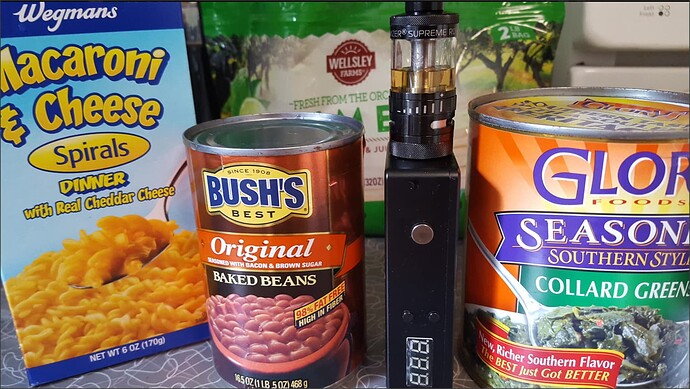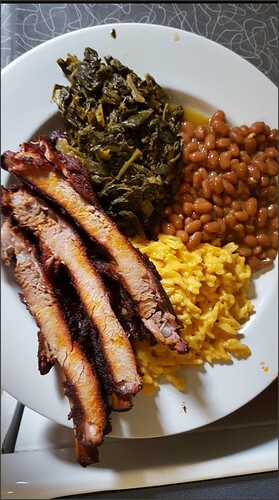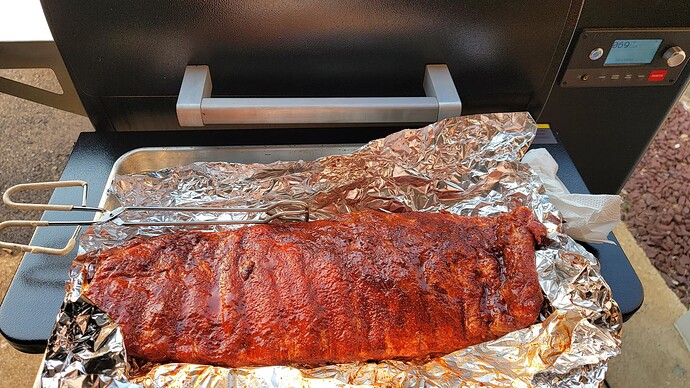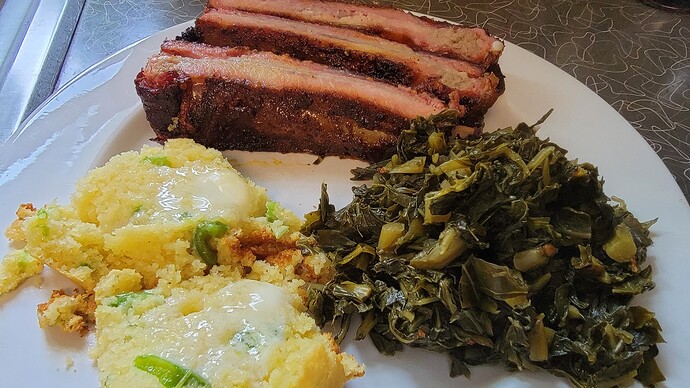@marsh8 EVERY time I’ve been to a great BBQ shack they’ve always had greens. I got addicted, and couldn’t stop. NOW, with all these left-overs, and my complete lack of time, and inability to make them fresh like @SthrnMixer, I may have to be on the hunt for some mo cans !!!
DO NOT make collard greens from scratch, or you’ll hate me and you both ![]() I dare say you’ll never buy another can.
I dare say you’ll never buy another can.
Hehe, probably true. ![]()
Why don’t we ever have “After pictures”??? Because we only see empty dishes.
Why do we cook things that could feed 6 of them and it’s only 4 of us? Because if we don’t, by the time we reach the table we’d only get the left-overs… and it’s NOT NICE!!!
I have a BIG work cookout coming, so I’m FINALLY fine tuning my ribs.
Between the dry rub and the Texas Crutch, I’m about 100% there.
Thus far, it looks like a Commercial Rub (tisk tisk) is really working out, and after fully coating the racks in Killer Hogs Hot BBQ Rub, and smoking for 3 hours, foiling for 1.5 hours with Honey, Brown Sugar, Butter, and 1/3C of Apple Juice, then back on the smoke for 1.5 hours seems to be working.
The Traeger Ironwood 650 Pellet Smoker has really proved to be impressive, and despite decades of stick built and/or Charcoal smokers, it’s getting a workout this, it’s first year. Having used all of Traeger’s pellets, the Pecan has really turned out to be our favorite.
Is it the same as stick built ?? Not quite, but with the Super Smoke setting on the Traeger, the gap is narrowing !!!
What do you mean by this?
Hehe, I’m sorry @marsh8. Assuming it came FROM Texas, BBQ’ers would foil their meats to speed cooking, prevent “stalling”, and allow for additional profiles to be added to the meat by including in the foil when foiling.
The old method was 3-2-1, 3 hours smoke, 2 hours foil, 1 hour back on the smoke to setup. About EVERY time I’ve tried that, the 2 hours in the foil was TOO much, and the meat grew either soggy, or fell off the bone. I’ve had MUCH better luck using a 3-1.5-1.5.
The added “benefit” of foiling (beyond getting through the stall with Brisket), is that you can ADD profiles/ingredients IN the foil, to add more profiles to the finished BBQ. I have had such good luck with Brown Sugar, Honey, Butter, and Apple Juice, I’ve not deviated from that.
I was watching something similar but this fella was using butcher paper, that made sense to me, allowed the meat to breathe a bit more
Oh YES @marsh8, you can. I’ve got a commercial roll of pink butcher’s paper, and I use that for bigger cuts like Brisket, etc. For ribs I use the foil to contain the extra ingredients, and DO want it to steam the meat a bit. Butcher’s paper allows you to included ingredients, and get SOME of the Steam Effect, but nowhere as much as foiling.
It’s voodoo witchcraft for sure.
Fascinating, to me…
When you smoke a large cut like brisket or pork butt, it will appear to stop cooking when the temperature hits 150-160 degrees Fahrenheit. That’s because the evaporated moisture is cooling the surface of the meat faster than the smoker can keep up with it.
This temperature plateau, called “the stall,” can last 5 or 6 hours
Hehe, yes it is. I know years ago (and I think with many/most newer BBQ’ers), the “Stall” turns into “PANIC” hehe.
I can’t say that Brisket is what I do best, BUT, I always wrap, and have never had a scary stall since.
When you read it, it doesn’t always make sense, until you witness it.
@whthek that article was actually quite good, dispelled some myths, and got to the “meat” of it.
What Causes the Stall?
Before we explain the true answer, let’s dispel a few common myths.
Myth #1: Collagen to Gelatin
For a long time, people believed that the stall occurred when the collagen in the meat combined with moisture to transform into gelatin. Because this happens at around 160 degrees, the inference is understandable.
However, correlation is not causation. The average brisket will only be about 2 percent collagen, which isn’t enough to offset the heat from the smoker during this transition.
Myth # 2: Fat Rendering
Similarly, experts have posited that fat rendering was to blame. Since the average beef brisket is 15 to 20 percent fat, this is a viable theory. However, tests have proven that pure fat will continue to heat up during a long, slow cook. That’s because fat doesn’t evaporate—it simply melts, which requires less thermal energy.
Myth #3: Protein Denaturing
Protein denaturing refers to the process of long chain molecules breaking down. This occurrence requires heat energy, so it makes sense that the temperature of the brisket would lower slightly as a result. It also happens around 140 to 150 degrees, which coincides with the timing of the stall. Still, protein denaturing doesn’t require nearly enough heat to cause the temperature to halt for hours on end.
Evaporative Cooling Defined
So, what really causes the stall? The true answer is both more and less complicated than these misconceptions.
The scientific term for it is evaporative cooling. You and I would refer to the same process as sweating.
That’s right—as the brisket is exposed to heat, the moisture in the meat slowly evaporates. Just as human perspiration has the effect of cooling the body down, so does the brisket “sweat” cool the meat and slow down the barbecue.
When you think about it, the phenomenon makes perfect sense. If you’ve ever cooked a large piece of meat before, you’ve likely noticed that its weight drops significantly after it’s done. That’s because of all the moisture that was lost through exposure to the heat.
At a certain point—about 150 degrees—this cooling effect is enough to counteract the heat of the smoker. That’s what causes the temperature to halt. The stall ends when all of the moisture has evaporated away, allowing the temperature to rise again.
I can definitely see a smoker in my future…I watched the video of the 3 different method’s used, and seeing the finished product(s) come off the smoker is just WOW
Perfect way to inexpensively feed people(like at your upcoming party) and impress them with the whole process at the same time! ![]()
If anyone here subscribes to Master Class, check out Aaron Franklin’s. It’s quite informative and he goes into a bit of the science of the stall. However, nothing more detailed really than what @SessionDrummer explained above. But his brisket class is worth the cost of admission.
What I will say is this. If using a pellet smoker or another type where you have some good control of the temp up and down, then cranking it up at the stall will definitely help get through it quicker. Example - you’re cooking a brisket at 250F. The internal temp of the brisket hits 162F and then hangs there for 1 hour. You’re in the stall. Crank the smoker up to 300F till you see that steady rise of internal temp again, then lower it back down.
It’s at this point, just past the stall, where I will always wrap the brisket. Reason is the meat squeezed out a lot of moisture during the stall, and now has relaxed again but is also dryer. Wrapping helps mitigate further moisture loss, and the use of butcher paper helps preserve all that lovely bark you just spent the last 10ish hours creating.
FYI I just did a brisket on my new kamado. Very impressed with how this thing cooks. Also enjoying the journey of learning something new.
So, really, no matter the cut, once reaching 150-160F which, from what I’ve read is where the stall start’s, you could wrap, and increase heat without waiting to see exactly where the stall started…maybe shaving a bit of cook time off?
The sweating effect makes sense! I naturally around the stalling temp always wrap, but it was more of an instinct, rather then knowing why it happens and the same not only goes for briskets ribs or pulled, but also for Turkey legs and things like that (see above my pics).
So thank you @SessionDrummer and @SthrnMixer for going deeper into this, at least I now know why I do it, instead of… I Just do it coz it’s the right way to do it…
@whthek I’m no competition BBQ competitor, but the only times I worry about temp probes, stalls, and wrapping to prevent are with bigger cuts, like Brisket, etc.
Wrapping can help you push through the stall much faster (and get back to your BBQ party) as opposed to wait, wait, waiting for meats to be done.



